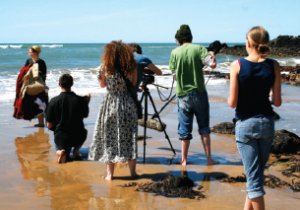Hollywood spends £1m for every minute of a completed film. How can it be done for a mere £100 a minute? Elizabeth Jane Baldry has found that all things are possible with fun, friendship and fairy cakes.


Once upon a time, fairy tales were for everyone. They entertained us and communicated fundamental truths, underlying fears and obsessions. The makers of early fairy tale films (such as Georges Melies in the 1890s and Walt Disney from 1922 onwards) were mostly male, and they reflect traditional gender roles. The primary connection with fairy tales for many of today’s children is through film. Considering the importance of fairy tales to the socialisation of children, how helpful is it that our kids are immersed in these bowdlerised versions? Einstein said, “If you want your children to be intelligent, read them fairy tales. If you want them to be brilliant, read them more fairytales.” As a child I devoured fairy tales, and as an adult I incorporated my passion into my work as a concert harpist by researching Victorian harp music inspired by fairies and British fairy tales. Telling these stories to my own children evolved into a film making group that brings together over a hundred people every summer.
Our first film happened by accident. My kids and their friends were complaining that there was nothing to do in the holidays. “Let's make a movie!” I said, rashly. A fairy tale was an inevitable choice. Everything was guesswork at first. I wrote the screenplay, made the costumes and dressed the sets. After attending a one-day course in camera skills, I hired a professional camera and filmed the movie with one of the kids holding the sound boom. The shoot lasted six days. I learnt how to edit in the subsidised edit suite at Phoenix Media. The whole thing cost under £300. We hired a cinema as a bit of fun. We didn't publicise the screening, but word got out and a surprisingly large number of people turned up, laughing and enjoying the film.
The following year we won a Phoenix Media Bursary (available to Devon film-makers) to produce another film. We chose ‘Pottle o’ Brains’ – a gem of an English folktale with a delicious feminist message. I’d taken a few more training courses and a professional cameraman had joined the team. We created the Chagford Filmmaking Group, a non-profit community group dedicated to producing films of British fairy tales, to harness the collective creativity of our village. Our third film was ‘Childe Rowland’, a British folktale possibly dating back to Anglo-Saxon times. In 2007, we shot ‘Cherry of Zennor’, and by a stroke of (fairy?) luck we chose the only sunny week in that wet summer. Each film developed a different aspect of the film-making process: project management; actors’ performances; involving as many kids as possible to focus on community film-making; technical skills, aiming to produce a film to broadcast quality; character depth and strong story-telling.
Our team includes concept artist Alan Lee who won an Oscar for designing the ‘Lord of the Rings’ trilogy; sculptress Armorel Hamilton who creates from Alan’s designs; cinematographer Will Halfacree from television production company TwoFour; BAFTA-winning dubbing mixer Paul Roberts; two young costume graduates Gabrielle Faeth Peckham and Laura Mackrill; our mentor and stills-photographer Brian Skilton, a retired producer with a lifetime’s experience in the industry. Our designer Sofia Cole used to work in the theatre and is responsible for the enchanted look of all our fairies. These inspiring individuals and many other volunteers give freely of their time and talent. The score needs to be composed using the available musicians – friends who will perform for their train fare, and good cake of course. Cake is always offered at committee meetings and given as thank-you presents. Naturally, the tea lady is the most revered volunteer on the shoot.
Creative ideas are invited from everyone including the children, The opportunity to be creative is irresistible and revives adult lives deadened by routine. The youngsters gain experience, and we are inspired by their energy and playfulness. Young film graduates gain references to support applications for paid employment. Our cross-generational projects unite us through friendship. The main artistic constraint is the limited number of children we can have as extras – costumes for film must withstand close-ups and therefore require skilled volunteers to make them. We make as few sets as possible because of time and cost.
There is a further motivation: we despair at the poor quality of so much children’s television. The pace of programmes we used to watch when we were young, were gentle and heart-warming, with enchanting scores played by real musicians. We care about producing films of heart, humanity and eloquence of landscape. What can we do on our shoestring budgets faced with the crassness of modern kids’ TV, the early sexualisation of girls and the pressures of modern life? Fairy tales can offer an answer. The hero sets out with nothing but three farthings and half a loaf of stale bread. The journey’s end is unknown; the call of adventure, the sense of mission and the spirit of friendship itself are justification enough.
Elizabeth-Jane Baldry is a professional concert harpist. She performs internationally and is the world’s only silent movie harpist.
e: info@fairytalefilms.co.uk
w: {www.fairytalefilms.co.uk}; {www.fairyharp.com}



